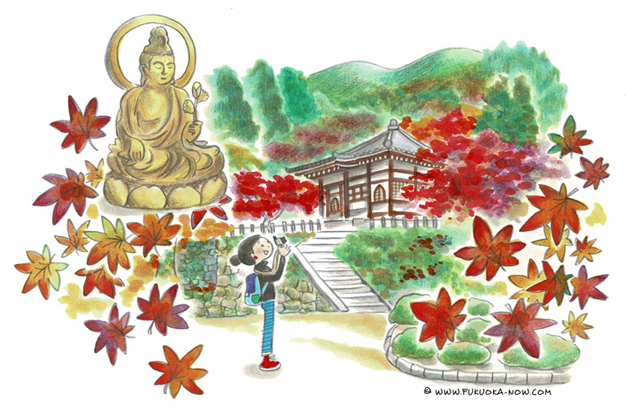Hakata Culture vol.177
Aburayama Kannon: Home of Beautiful Fall Foliage and More

Aburayama, a mountain that stretches across the southern part of Fukuoka City, is known for its great vistas. From the Katae Observatory, located halfway up the mountain, you can enjoy an exceptional panoramic view of the city, both day and night. The name Aburayama is said to have originated from the fact that a high priest named Seiga Shonin, who came from the Western Regions (parts of present-day Central Asia and India), was the first person in Japan to refine oil (abura in Japanese) from camellia fruits. The place where he did this is Aburayama Kannon, or Shokakuji Temple, located just below the observatory.
The history of Aburayama Kannon dates back to the Tenpyo era (729~748) when Seiga Shonin is said to have enshrined a thousand-armed Kannon (Goddess of Mercy) that he carved out of a white camellia tree. Originally called Senpukuji Temple, the temple once flourished to the extent that it had housing quarters for several hundred monks, but most of these were lost to fire during the Tensho era (1573~1592) of the Warring States period. The temple was later rebuilt and renamed Shokakuji Temple in 1694. Today, many people still refer to the temple as Aburayama Kannon.
The wooden seated statue of Kannon enshrined in the main hall is said to date from the Heian era (794~1185) and has been designated by the national government as an important cultural property. The temple is also home to Hibari Kannon Hall, which is dedicated to Hibari Misora, a singer from the Showa era who was considered a national icon. It is equipped with a device that plays her songs when you insert coins. Standing at the entrance to the temple grounds is a gate made of stone, which is an unusual building material for a temple gate. It is a Silla-style stone gate that was built using ancient Korean techniques by a single trainee monk in the Meiji era.
The kayu-biraki (literally, "porridge opening") event held every year on Feb. 1 is a ritual for predicting the fertility of the year's crops based on the state of a bowl of azuki porridge left in the main hall for half a month. It is said that Tsunamasa Kuroda, the fourth lord of the Fukuoka domain, revived the event, whose practice has been discontinued, in 1695. The precincts of the temple are also known for their fall foliage, and the bright red maples are magnificent in late fall. Here you can enjoy the beautiful autumn colors while listening to the chirping of wild birds.
紅葉も美しい油山観音正覚寺
福岡市の南部に広がる油山は眺望がいいことで知られています。中腹にある片江展望台からは福岡の市街地をパノラマのように見渡すことができ、昼間はもちろん夜景の美しさも格別です。油山という名前は、西域(現在の中央アジアやインド周辺)から渡来した清賀上人が、日本で初めて椿の実から油を精製したことに由来するとされます。その場所が展望台の少し手前にある油山観音正覚寺です。
油山観音正覚寺は、天平年間(729~748)に清賀上人が白椿の木で千手観音を彫って安置したことが始まりとされます。当初は泉福寺と呼ばれていて、一時は数百もの僧坊を持つほど栄えますが、戦国時代の天正年間(1573~1592)にほとんど焼失してしまいます。その後、寺が再建されて元禄7年(1694)に正覚寺と改められました。現在は油山観音の名前でも親しまれています。
本堂に安置されている木造の聖観音坐像は平安時代の作とされ、国の重要文化財に指定されています。また、昭和の国民的歌手・美空ひばりをまつった「ひばり観音堂」があり、お金を入れると美空ひばりの曲が流れる仕掛けもあります。境内入り口に立つのはお寺の山門としてはめずらしい石造りの門。明治時代、修行僧がたった一人で造り上げた古代朝鮮の技法を用いた新羅式石門です。
歴史ある行事も多く、毎年2月1日に行われる「粥開き」は本堂に半月置いた小豆粥の状態でその年の農作物の豊凶を占うもの。一時は途絶えていた行事を、福岡藩4代藩主・黒田綱政が元禄8年(1695)に再興したと伝わります。境内は紅葉の名所としても知られていて、晩秋の頃には赤く燃えるようなカエデが見事です。野鳥の声を聞きながら、美しい紅葉を楽しむことができます。

